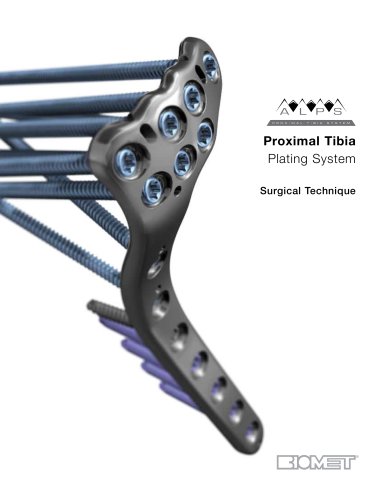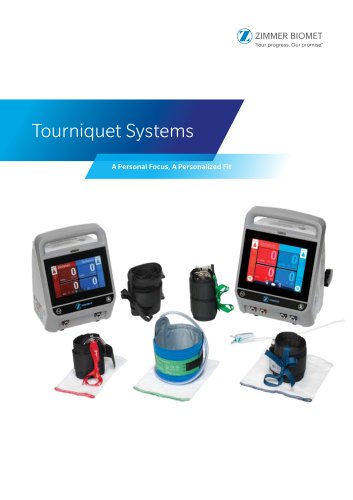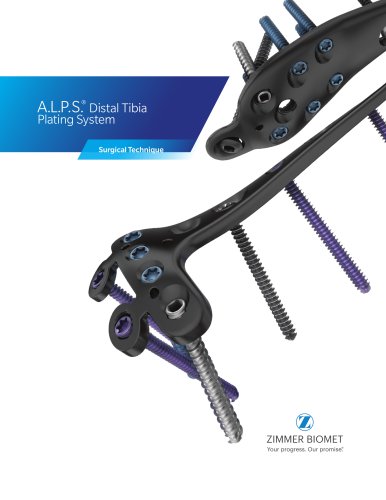
Catalog excerpts
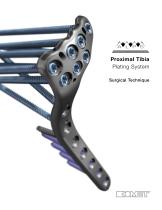
Proximal Tibia Plating System Surgical Technique
Open the catalog to page 1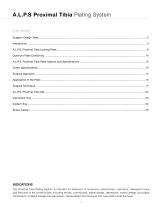
INDICATIONS The Proximal Tibia Plating System is intended for treatment of nonunions, osteotomies, malunions, osteopenic bone and fractures of the proximal tibia, including simple, comminuted, lateral wedge, depression, medial wedge, bicondylar combination of lateral wedge and depression, periprosthetic and fractures with associated shaft fractures. 1
Open the catalog to page 3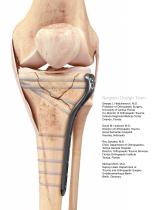
Surgeon Design Team George J. Haidukewych, M.D. Professor of Orthopaedic Surgery, University of Central Florida Co-Director of Orthopaedic Trauma, Orlando Regional Medical Center Orlando, Florida Director of Orthopaedic Trauma Good Samaritan Hospital Kearney, Nebraska Chief, Department of Orthopaedics, Tampa General Hospital Director, Orthopaedic Trauma Services, Florida Orthopaedic Institute Tampa, Florida Deputy Head, Department of Trauma and Orthopaedic Surgery Unfallkrankenhaus Berlin Berlin, Germany
Open the catalog to page 4
A.L.P.S Proximal Tibia Plating System Introduction Prominent proximal tibia implants can cause discomfort and wound breakdown in the post-operative period. The low profile A.L.P.S. plates are specifically designed to match the anatomy of the proximal tibia, with minimal implant thickness, while still having the required strength. As a result of a thorough development process, using hundreds of CT scans from a variety of races and genders, the design team was able to match the diversity of proximal tibial anatomy into two unique lateral proximal tibia plate shapes. The distinction lies...
Open the catalog to page 5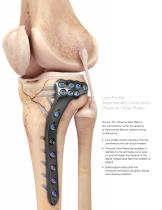
Low ProfileAnatomically Contoured Proximal Tibial Plates The A.L.P.S. Proximal Tibia Plate is pre-contoured to mimic the anatomy of the proximal tibia for optimum bone conformance. • Low profile contouring helps minimize prominence and soft tissue irritation • Proximal Tibia Plates are available in standard curve and large curve sizes to accommodate the variance in the lateral metaphyseal flare from patient to patient • Bullet-tipped distal plate end minimizes soft tissue disruption during percutaneous insertion
Open the catalog to page 6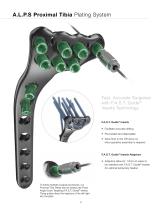
A.L.P.S Proximal Tibia Plating System Fast, Accurate Surgeries with F.A.S.T. Guide ® Inserts Technology F.A.S.T. Guide® Inserts • Facilitate accurate drilling • Pre-loaded and disposable • Save time in the OR since no intra-operative assembly is required F.A.S.T. Guide® Inserts Adaptors • Adaptors allow for 1.6mm K-wires to be inserted over F.A.S.T. Guide® Inserts for optimal temporary fixation To further facilitate surgical procedures, our Proximal Tibia Plates are pre-loaded with Fixed ® Angle Screw Targeting (F.A.S.T.) Guide Inserts. These guides direct the trajectory of the drill right...
Open the catalog to page 7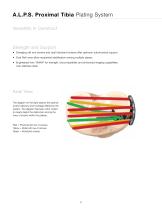
• Diverging raft row screws and dual kickstand screws offer optimum subchondral support • Dual Raft rows allow sequential stabilization among multiple planes • Engineered from TiMAX® for strength, biocompatibility and enhanced imaging capabilities over stainless steel Axial View The diagram on the right depicts the optimal screw trajectory and coverage offered by the system. The diagram has been color coded to clearly depict the distinction among the rows of screws within the plateau. Red = Proximal raft row of screws Yellow = Distal raft row of screws Green = Kickstand screws
Open the catalog to page 8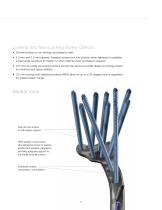
Locking and Non-Locking Screw Options • Choose locking or non-locking, according to need • 4.0 mm and 3.5 mm tapered, threaded screws lock into position when tightened to establish a fixed angle construct for fixation or when optimal screw purchase is required • 3.5 mm low profile non-locking screws provide the same low profile design as locking screws for minimum soft tissue irritation • 3.5 mm locking multi-directional screws (MDS) allow for up to a 25 degree cone of angulation for greater fixation range Medial View Dual raft row screws for full plateau support Wide spread of raft screws...
Open the catalog to page 9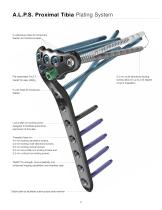
A.L.P.S. Proximal Tibia Plating System K-wire/suture holes for temporary fixation and meniscus repair Pre-assembled F.A.S.T. Guide® for easy drilling 3.5 mm multi-directional locking screws allow for up to a 25 degree cone of angulation K-wire holes for temporary fixation Low profile non-locking screw designed to facilitate anatomical placement of the plate Threaded holes for: 4.0 mm locking cancellous screws, 3.5 mm locking multi-directional screws, 3.5 mm locking cortical screws, 3.5 mm low profile non-locking screws and 3.5 mm cortical non-locking screws TiMAX® for strength,...
Open the catalog to page 10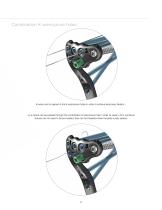
Combination K-wire/suture holes K-wires can be placed in the K-wire/suture holes in order to achieve temporary fixation... ..or a suture can be passed through the combination K-wire/suture hole in order to repair a torn meniscus. Sutures do not need to be pre-loaded, they can be threaded when the plate is fully seated.
Open the catalog to page 11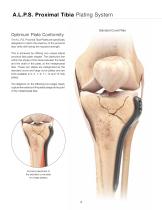
A.L.P.S. Proximal Tibia Plating System Standard Curve Plate Optimum Plate Conformity The A.L.P.S. Proximal Tibia Plates are specifically designed to match the anatomy of the proximal tibia while still having the required strength. This is achieved by offering two unique lateral proximal tibia plate shapes. The distinction lies within the shape of the slope between the head and the shaft of the plate, at the metaphyseal flare. These two plates are categorized as the standard curve and large curve plates and are both available in 3, 5, 7, 9, 11, 13 and 15 hole plates. The diagrams on the...
Open the catalog to page 12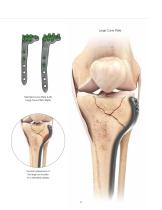
Large Curve Plate Standard Curve Plate (Left) Large Curve Plate (Right) Incorrect placement of the large curve plate on a standard plateau
Open the catalog to page 13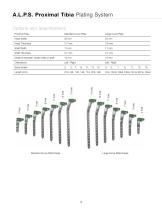
Options and Specifications Proximal Tibia Standard Curve Plate Head Width Large Curve Plate 34 mm Head Thickness Shaft Width Shaft Thickness Distance between center holes of shaft Sizes (holes) Length (mm) Left / Right Left / Right Standard Curve Plate Range
Open the catalog to page 14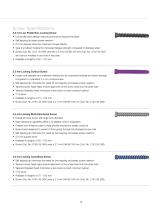
3.5 mm Low Profile Non-Locking Screw: • Low profile head design reduces prominence beyond the plate • Self tapping tip eases screw insertion • 2.2 mm Square driver for maximum torque delivery • Type II anodized material for increased fatigue strength compared to stainless steel • Screw (Cat. No.1312-18-0XX) uses the 2.5 mm Drill Bit 100 mm (Cat. No. 2142-35-007) and can be installed in any hole in the plate 3.5 mm Locking Cortical Screw: • Larger core diameter and shallower thread pitch for improved bending and shear strength compared to a standard 3.5 mm cortical screw • Self tapping tip...
Open the catalog to page 15All Zimmer Biomet catalogs and technical brochures
-
ROSA ONE® Brain System
7 Pages
-
MODULAR FEMORAL Revision System
14 Pages
Archived catalogs
-
A.L.P.S.®
44 Pages
-
Constrained Posterior Stabilized
12 Pages
-
Persona PERSONALIZED KNEE
7 Pages
-
Avenir® Femoral Hip System
12 Pages
-
The CLS® Spotorno® Stem
16 Pages
-
Alloclassic®Zweymüller®Stem
12 Pages
-
®Zimmer® Segmental System
6 Pages
-
NexGen® RH Knee
8 Pages
-
Persona-Partial
12 Pages
-
Zimmer Natural Nail System
8 Pages
-
tourniquet-systems-brochure
8 Pages
-
modern-cementing-technique
16 Pages
-
CoAxial Spray Kit
8 Pages
-
Biologics
24 Pages
-
PowerPump DP System
2 Pages
-
Sidus
40 Pages
-
Ankle Fix System 4.0
8 Pages
-
Anatomical Shoulder System
6 Pages
-
Fitmore Hip Stems
6 Pages
-
NexGen High-Flex Implant
8 Pages
-
Trabecular Metal ™Glenoid
4 Pages
-
Anatomical Shoulder ™ System
6 Pages
-
Zimmer ® PSI Shoulder
6 Pages
-
Zimmer personna
12 Pages
-
ZImmer iASSIST
44 Pages
-
Fitmore ® Hip Stem
24 Pages
-
Persona Knee
6 Pages
-
Trauma Solutions
10 Pages
-
Colagen Repair Patch
2 Pages
-
Fitmore® Hip Stem
6 Pages
-
Zimmer® Segmental System
6 Pages

